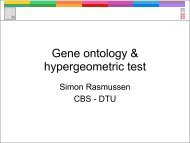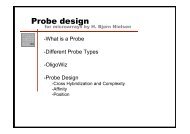Computational tools and Interoperability in Comparative ... - CBS
Computational tools and Interoperability in Comparative ... - CBS
Computational tools and Interoperability in Comparative ... - CBS
Create successful ePaper yourself
Turn your PDF publications into a flip-book with our unique Google optimized e-Paper software.
where match states stop around 10 columns from the<br />
end of the alignments effectively caus<strong>in</strong>g the HMM to<br />
predict the last conserved nucleotide of the consensus<br />
sequence rather than the stop of the rRNAs. Hence, it is<br />
not uncommon for the stop position of the 5S to be<br />
predicted up to 10 nt downstream of the annotated stop<br />
position.<br />
These effects can also expla<strong>in</strong> the endpo<strong>in</strong>t accuracy<br />
that was seen when we compared our results to<br />
experimentally determ<strong>in</strong>ed 16S sequences. We tried to<br />
f<strong>in</strong>d sequences where the ends had been experimentally<br />
verified by RACE or PCR, but such rRNAs proved<br />
difficult to f<strong>in</strong>d. All the ones we selected were sequenced,<br />
but it is uncerta<strong>in</strong> to what extent the authors had<br />
tried to determ<strong>in</strong>e the ends. These experimentally<br />
found rRNAs did show better agreement with annotation<br />
than predictions <strong>in</strong> general, although this is not sufficient<br />
to conclude that our predictions are more accurate. Our<br />
stop predictions were very accurate, but more deviation<br />
was seen <strong>in</strong> the start predictions. These results could reflect<br />
more variation <strong>in</strong> the beg<strong>in</strong>n<strong>in</strong>g of the alignments, which<br />
as <strong>in</strong> the 5S case could effectively cause the HMM to<br />
predict the last conserved nucleotide of the consensus<br />
sequence rather than the end of the rRNAs.<br />
In some cases, larger endpo<strong>in</strong>t deviations occur. This<br />
can happen when one of the ends of the model f<strong>in</strong>ds a<br />
better match <strong>in</strong> a different part of the sequence. Insertion<br />
states sometimes allows the HMM to <strong>in</strong>sert long gap<br />
regions <strong>and</strong> thus f<strong>in</strong>d a match<strong>in</strong>g stop position far from<br />
the rest of the sequence. As shown for the bacterial 16S<br />
sequences that displayed this phenomenon, this is less of a<br />
problem when the spotter model is employed. The w<strong>in</strong>dow<br />
searched around the spotter hit would most likely be too<br />
short to accommodate such an <strong>in</strong>sert, <strong>and</strong> the model<br />
would match with the proper sequence.<br />
For fragmented rRNAs, long gap regions may be<br />
correctly predicted. This was seen for Coxiella burnetii 23S<br />
where our prediction has the same start position<br />
as annotated, but where the predicted stop position<br />
is 1884 nt downstream of GenBank’s stop position.<br />
However, accord<strong>in</strong>g to Entrez Gene, this rRNA appears<br />
<strong>in</strong> four pieces <strong>and</strong> with the same stop position as ours,<br />
suggest<strong>in</strong>g that <strong>in</strong> some cases ‘too long’ predictions might<br />
actually be correct. These cases should normally not be<br />
masked when us<strong>in</strong>g the spotter unless <strong>in</strong>serts between the<br />
fragments would make it exceed the w<strong>in</strong>dow size.<br />
The HMM produced by HMMer requires time of order<br />
O(NM) to search a sequence of length N us<strong>in</strong>g a model<br />
with M states, M be<strong>in</strong>g proportional to the length of the<br />
multiple alignment. However, the speed is <strong>in</strong>creased by<br />
us<strong>in</strong>g a 75 nt long spotter model to pre-screen the<br />
sequence, which requires time of order O(N), <strong>and</strong> then<br />
runn<strong>in</strong>g the full HMM on w<strong>in</strong>dows around each spotter<br />
hit which requires time of order OðKM 2 Þ for K spotter<br />
hits, <strong>and</strong> w<strong>in</strong>dow size proportional to M. The benefit of<br />
us<strong>in</strong>g the spotter is clearly illustrated <strong>in</strong> the M. capricolum<br />
searches. However, the time difference between the<br />
S. usitatus <strong>and</strong> the Sargasso Sea data searches shows<br />
that the spotter might lose its mission when deal<strong>in</strong>g with<br />
many shorter sequences.<br />
Nucleic Acids Research, 2007, Vol. 35, No. 9 3107<br />
There are other approaches to predict<strong>in</strong>g non-cod<strong>in</strong>g<br />
RNA. One commonly used method is sequence alignment,<br />
e.g. BLAST (3), Paralign (20) or FASTA (21). Another is<br />
based on structure-sensitive Stochastic Context Free<br />
Grammars (SCFG) (22) which form the basis of the<br />
tRNA prediction program tRNAscan-SE (23) <strong>and</strong> of<br />
Infernal (24), which is used when creat<strong>in</strong>g RFAM. While<br />
the sequence alignment methods are very fast, they are not<br />
particularly suited for prediction of non-cod<strong>in</strong>g RNA (1).<br />
Infernal, however, has a general worst case runn<strong>in</strong>g time<br />
of order OðMN 3 Þ, which is prohibitive. The RFAM<br />
database (17,18), which <strong>in</strong>cludes 5S <strong>and</strong> the 5 0 doma<strong>in</strong><br />
of 16S, uses BLAST to pre-screen genome sequences,<br />
followed by Infernal; despite a more efficient approach<br />
than the general SCFG, it does not analyze the entire 16S.<br />
A search for 5S <strong>in</strong> a 1 Mbp genome us<strong>in</strong>g Infernal took<br />
4 hours 45 m<strong>in</strong>utes: almost 1000 times as much as the<br />
16 seconds used by RNAmmer for the much larger 16S<br />
model. A time-sav<strong>in</strong>g approach to SCFGs could be to use<br />
the RaveNna (25) package which can convert an RFAM<br />
SCFG to an HMM. This drastically reduces the runn<strong>in</strong>g<br />
time; however, its usefulness would be limited s<strong>in</strong>ce no<br />
models for the larger rRNAs are available. Another factor<br />
is that the 5S found by RaveNna (26) which were not<br />
already <strong>in</strong> RFAM were all <strong>in</strong> organellar sequences,<br />
sequences not analyzed by RNAmmer. For further<br />
comparisons <strong>and</strong> comments on these different methods,<br />
we refer to (1).<br />
The RNAmmer program is available as a traditional<br />
HTML-based prediction server at http://www.cbs.dtu.dk/<br />
services/RNAmmer as well as through a SOAP-based<br />
web service. It is also available for download through<br />
the same site.<br />
SUPPLEMENTARY DATA<br />
Supplementary Data is available at NAR onl<strong>in</strong>e.<br />
ACKNOWLEDGEMENTS<br />
We are grateful for fund<strong>in</strong>g from EMBIO at the<br />
University of Oslo, the Research Council of Norway<br />
<strong>and</strong> the Danish Center for Scientific Comput<strong>in</strong>g. It was<br />
also supported by a grant from the European Union<br />
through the EMBRACE Network of Excellence, contract<br />
number LSHG-CT-2004-512092. We would also like to<br />
thank our colleagues for critical read<strong>in</strong>g of the manuscript.<br />
Fund<strong>in</strong>g to pay the Open Access publication charge<br />
was provided by Research Council of Norway.<br />
Conflict of <strong>in</strong>terest statement. None declared.<br />
REFERENCES<br />
1. Freyhult,E., Bollback,J. <strong>and</strong> Gardner,P. (2007) Explor<strong>in</strong>g genomic<br />
dark matter: a critical assessment of the performance of homology<br />
search methods on noncod<strong>in</strong>g RNA. Genome Res., 17, 117–125.<br />
2. Pedersen,A., Jensen,L., Brunak,S., Staerfeldt,H. <strong>and</strong> Ussery,D.<br />
(2000) A DNA structural atlas for Escherichia coli. J. Mol. Biol.,<br />
299, 907–930.<br />
3. Altschul,S., Gish,W., Miller,W., Myers,E. <strong>and</strong> Lipman,D. (1990)<br />
Basic local alignment search tool. J. Mol. Biol., 215, 403–10.









